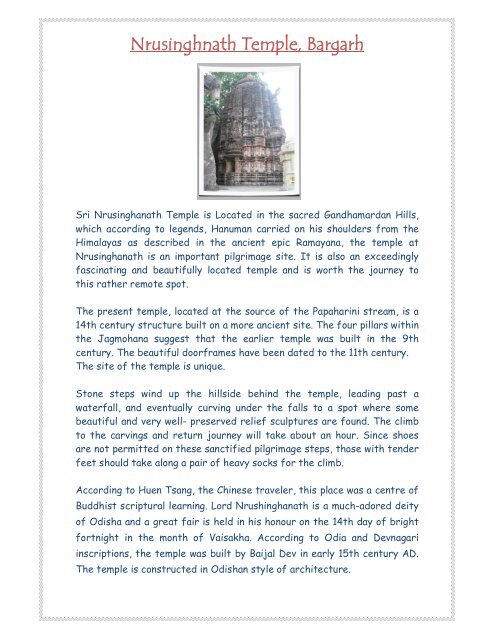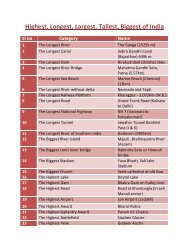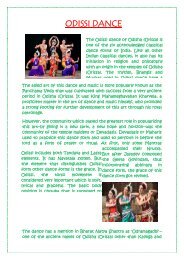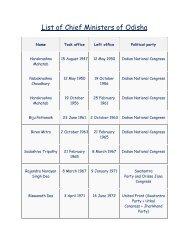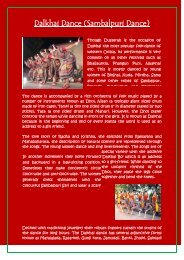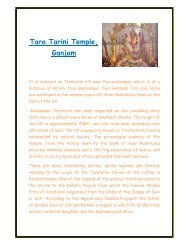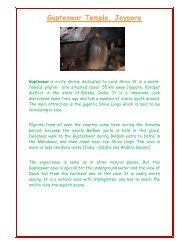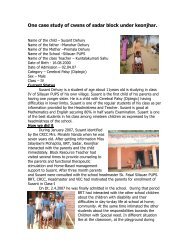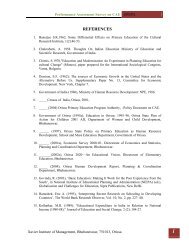Nrusinghnath and Harishankar Temple
Nrusinghnath and Harishankar Temple
Nrusinghnath and Harishankar Temple
You also want an ePaper? Increase the reach of your titles
YUMPU automatically turns print PDFs into web optimized ePapers that Google loves.
<strong>Nrusinghnath</strong> <strong>Temple</strong>, Bargarh<br />
Sri Nrusinghanath <strong>Temple</strong> is Located in the sacred G<strong>and</strong>hamardan Hills,<br />
which according to legends, Hanuman carried on his shoulders from the<br />
Himalayas as described in the ancient epic Ramayana, the temple at<br />
Nrusinghanath is an important pilgrimage site. It is also an exceedingly<br />
fascinating <strong>and</strong> beautifully located temple <strong>and</strong> is worth the journey to<br />
this rather remote spot.<br />
The present temple, located at the source of the Papaharini stream, is a<br />
14th century structure built on a more ancient site. The four pillars within<br />
the Jagmohana suggest that the earlier temple was built in the 9th<br />
century. The beautiful doorframes have been dated to the 11th century.<br />
The site of the temple is unique.<br />
Stone steps wind up the hillside behind the temple, leading past a<br />
waterfall, <strong>and</strong> eventually curving under the falls to a spot where some<br />
beautiful <strong>and</strong> very well- preserved relief sculptures are found. The climb<br />
to the carvings <strong>and</strong> return journey will take about an hour. Since shoes<br />
are not permitted on these sanctified pilgrimage steps, those with tender<br />
feet should take along a pair of heavy socks for the climb.<br />
According to Huen Tsang, the Chinese traveler, this place was a centre of<br />
Buddhist scriptural learning. Lord Nrushinghanath is a much-adored deity<br />
of Odisha <strong>and</strong> a great fair is held in his honour on the 14th day of bright<br />
fortnight in the month of Vaisakha. According to Odia <strong>and</strong> Devnagari<br />
inscriptions, the temple was built by Baijal Dev in early 15th century AD.<br />
The temple is constructed in Odishan style of architecture.
<strong>Harishankar</strong> <strong>Temple</strong>, Bolangir<br />
The foaming waters sparkle vibrantly, acting as an enjoyable contrast to<br />
the non-melting hardness of the granite bed from which it cascades<br />
through the sun-dappled jungle. Echoing its joyful song, birds <strong>and</strong> bathers<br />
thronging the pool shaped by the swirling waters seem to give thanks to<br />
'Hari' <strong>and</strong> 'Shankar', the reigning deities of <strong>Harishankar</strong> <strong>Temple</strong> perched<br />
on the southern slope of G<strong>and</strong>hamardan hill.<br />
The hillside is well-known for medicinal plants, which st<strong>and</strong> along Balangir-<br />
Sambalpur border. This 14th century temple is dedicated to Lord Shiva.<br />
The temple is noted for its charming design <strong>and</strong> exquisite architecture,<br />
which is different from the more well known Odisha style.<br />
The place is known as <strong>Harishankar</strong> after Hari Lord Vishnu <strong>and</strong> Sankara<br />
Lord Shiva, the dual deities of Hindu mythology. The plateau between the<br />
two temples is strewn with ancient Buddhist ruins. Which are considered<br />
to be remnants of the ancient University Parimalgiri.


